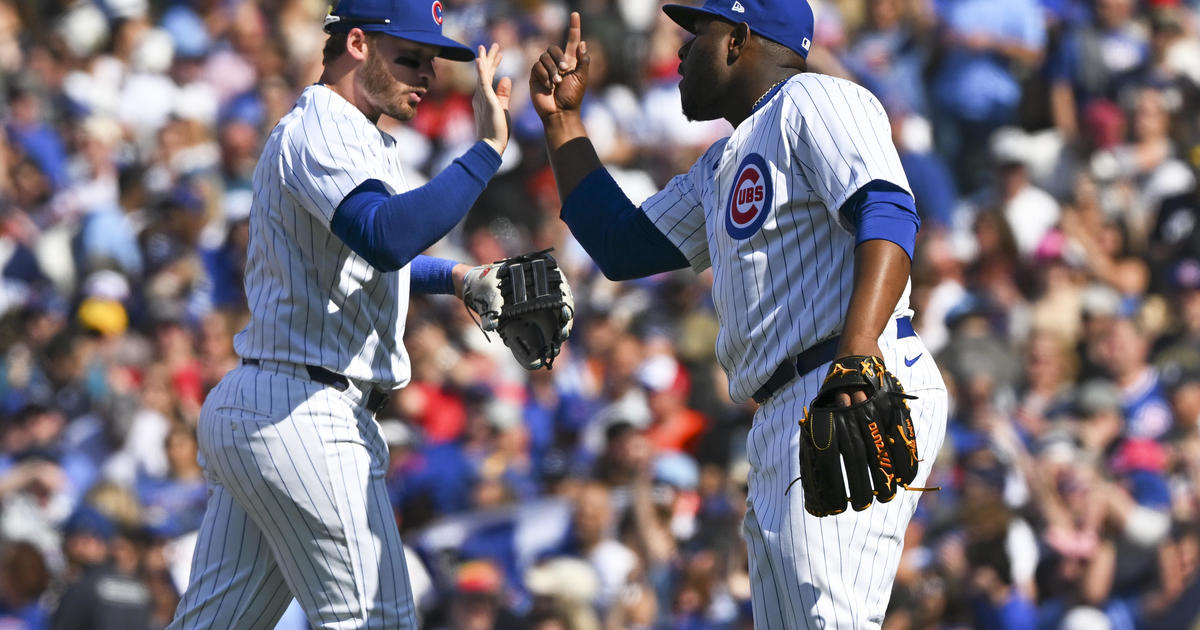Emma: Behind The Methods To Maddon's Lineup Madness
By Chris Emma--
CHICAGO (CBS) -- From zoo animals to magicians, perhaps no man in baseball history has bucked convention in managing quite like the Cubs' Joe Maddon. He's unique as they come.
But Maddon's greatest mark in progressing the game of baseball comes not with Simon the magician but rather Ben the super-utility star. Monday saw Ben Zobrist unveil a new branded cereal, "Zorilla Crunch," which will be available throughout Chicagoland Jewel locations starting Tuesday. It's a distinct honor for one of baseball's most versatile players.
Zobrist, now 35, became one of baseball's first super-utility standouts. He always posted solid numbers but never resounding in any particular box. Zobrist became invaluable because of his versatility. In fact, he's made a career of it, playing every position but pitcher and catcher in 12 years. Maddon forged this role with Zobrist during their days together in Tampa and it has continued in Chicago.
During his years managing in the minor leagues during the 1980s, Maddon was prepared to fight against convention when it came to versatility.
Maddon recognized that a second baseman could bring his athleticism to center field or a third baseman would manage well in left field. He's even willing to put a pitcher in at another position. But organizations weren't that willing to budge when it came to player development.
"You couldn't do it because it would retard their development -- that's all I ever heard," Maddon said Monday at Wrigley Field. "I didn't understand that. I thought it would get them there sooner and keep them there longer if they could do those things."
As the leader of the defending World Series champions, Maddon has had his way with versatility. Convention from those days in the '80s has mostly been bucked by bright baseball minds like Maddon.
Maddon even made a case for a designated super-utility player on each All-Star team. He brought in two super-utility players to the AL All-Star team in 2009 with Zobrist and Chone Figgins.
Versatility has a tremendous value in the majors, and Maddon can be regarded as the Christopher Columbus for what was once new territory in baseball world.
Let the manager explain the methods behind his madness.
Back in 2015, Kris Bryant wasn't even a week into his big league career when Maddon moved him to center field as part of a double switch. It was a position he hadn't played since college. Bryant started in center the next game and played left field a day later. He has also played first base and even an inning at shortstop during his career.
Bryant embraced the oddity. In fact, he felt it made his adjustment to the big leagues easier.
"There were some people that didn't like the idea that KB would play multiple positions being the best player, a potential Rookie of the Year, but then he was," Maddon said. (Versatility) doesn't retard anything. It's just a method of thinking that's archaic."
When Kyle Schwarber arrived at the big league level later in 2015, Maddon recognized his bat had to be in the lineup, so Schwarber moved to left field. Willson Contreras played left field, right field, third base and first base last season. Javier Baez has played every infield position plus two innings in left field and one in right.
Maddon isn't willing to keep an impactful bat from the lineup because of positional designations.
"Why have this mature bat being held back by a lack of a particular position?" Maddon asked rhetorically.
Of course, there's much more that Maddon will pull. Back in 1989, he made a case for a young left-handed pitching prospect by the name of Deshaun Moore as a position player. He threw 95 miles per hour and was the fastest player on the A-ball team. Maddon wanted him in the lineup during days he wasn't pitching. Angels general manager Dan O'Brien thought about it for what Maddon described as a "nanosecond" but said no.
Last season, reliever Travis Wood stepped in and made a play against the vines during a game early last August against Seattle. He came up during Game 2 of the NLDS and hit a home run against the Giants.
"We'll put the round peg in the square hole if it's necessary," Maddon explained. "Whenever you're losing, you do anything to win a game. You put a pitcher in left field. It doesn't matter if you're not winning that game, you try anything it takes to win that game."
Maddon's latest venture in versatility has come with rookie Ian Happ, the Cubs' first-round pick in 2015. A second baseman by trade, Happ has played all three outfield positions during his first seven games at the big league level. Initial plans were for Happ to return back to Triple-A Iowa when the Cubs got healthy in the majors. Happ forced their hand and remained.
"Right now, Happy can play anywhere as far as I'm concerned," Maddon said. "I'll put him anywhere when the bat's ripe. This guy's a good athlete and can play different positions."
Many managers would still refrain from Maddon's philosophies, even now 30 years since his time in the minors. But it's hard to argue with the success of Maddon, who just won his 1,000th game in the majors and owns a World Series ring.
During the early days of baseball, players would wear jersey numbers based on their place in the batting order. The 1927 Yankees featured Babe Ruth hitting third and wearing No. 3, with Lou Gehrig batting cleanup and wearing No. 4 on his jersey.
Maddon once made a Rays batting order spell out 8-6-7-5-3-0-9 (the center fielder leading off, shortstop hitting second, etc.) in honor of Tommy Tutone's hit song.
Damned be baseball convention. There's a method to Maddon's madness. He values versatility and understands its importance.
Players have learned to follow his lead. They've been rewarded with wins and cereal boxes.
Chris Emma covers the Bears, Chicago's sports scene and more for CBSChicago.com. Follow him on Twitter @CEmma670 and like his Facebook page.



